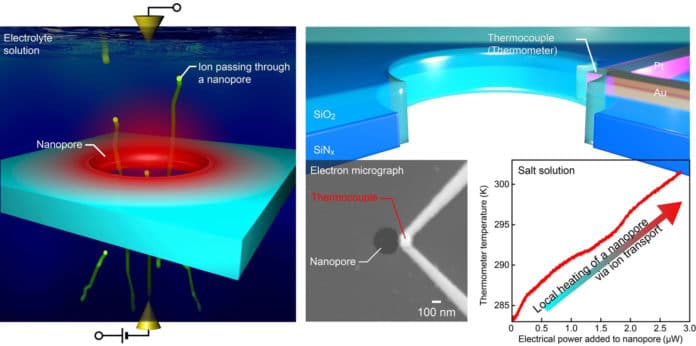Nanopores are an exciting new platform for building sensors. Often, an electrical voltage is applied between the two sides of the membrane to draw the substance to be analyzed through the nanopore.
Simultaneously, charged particles in the solution can be transported, yet their impact on the temperature has not been broadly contemplated. Direct measurement of the thermal effects caused by these ions can help make nanopores more practical as sensors.
Scientists from SANKEN at Osaka University measured the thermal effects of ionic flow through a nanopore using a thermocouple. They developed the thermocouple using gold and platinum nanowires with a point of contact of just 100 nm in size that served as the thermometer.
Scientists used it to measure the temperature directly next to a nanopore cut into a 40-nm-thick film suspended on a silicon wafer. Under most conditions, the current and heating power varied with applied voltage.
When electrical energy is converted to heat by the resistance wire, Joule heating occurs. The thermal energy was dissipated in proportion to the momentum of the ionic flow.
When studying a 300-nm-sized nanopore, scientists recorded the ionic current of phosphate-buffered saline as a function of applied voltage.
First author Makusu Tsutsui says, “We demonstrated nearly ohmic behavior over a wide range of experimental conditions.”
“With smaller nanopores, the heating effect became more pronounced because less fluid from the cooler side could pass through to equalize the temperature. As a result, the heating could cause a non-negligible effect, with nanopores experiencing a temperature increase of a few degrees under standard operating conditions.”
Senior author Tomoji Kawai says, “We expect the development of novel nanopore sensors that can not only identify viruses but might also be able to deactivate them at the same time.”
Journal Reference:
- Makusu Tsutsui et al., Ionic heat dissipation in solid-state pores, Science Advances (2022). DOI: 10.1126/sciadv.abl7002
